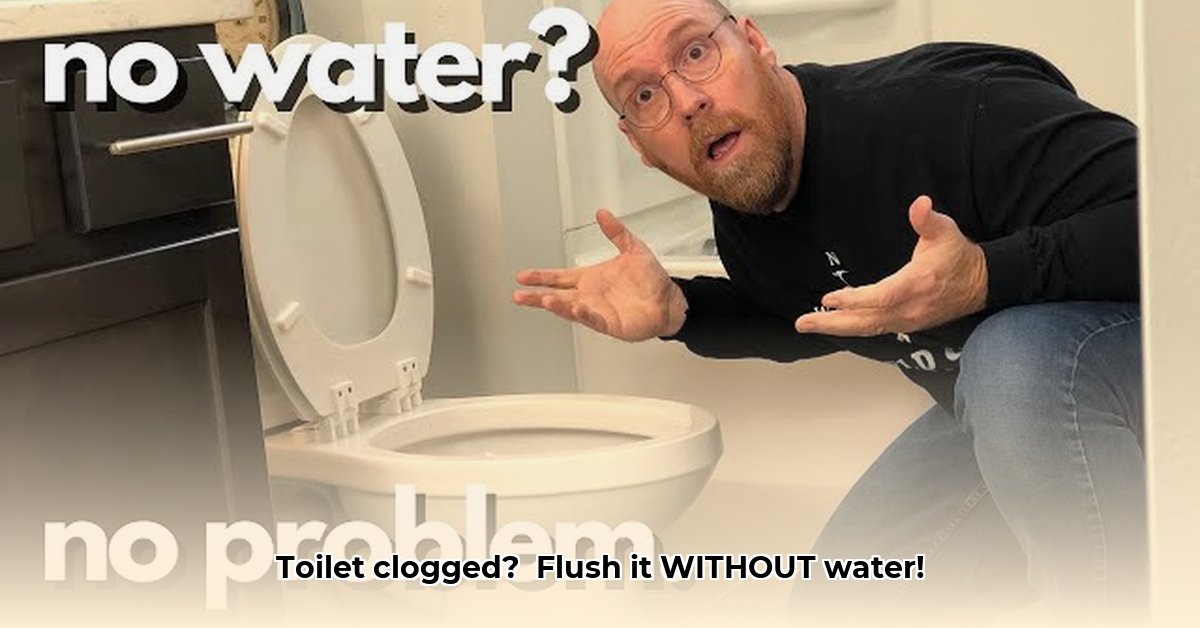Understanding Your Toilet and Gathering Supplies
Water outages can be disruptive, but flushing your toilet without running water is easier than you think. This guide provides clear, step-by-step instructions for both standard and tankless toilets. Preparation is key, so start by gathering the necessary supplies:
- Buckets: Two five-gallon buckets are ideal for transporting and pouring water.
- Water Source: Having 3-5 gallons of stored water readily available is essential. During an outage, alternative sources may include a water heater (turned off first!), rainwater collection barrels, or even bottled water as a last resort.
- Plunger: A sturdy, flange plunger is crucial for dislodging stubborn clogs. Ensure it’s in good condition, as a worn-out plunger is ineffective.
- Gloves (Recommended): Protect your hands and maintain hygiene during the process. Consider disposable gloves for easy cleanup.
- Cleaning Supplies: Disinfectant wipes or spray and paper towels are essential for maintaining a sanitary environment, especially during water outages.
Storing water specifically for toilet flushing is a highly recommended practice, especially in areas prone to water disruptions. Aim for 5-10 gallons per person in your household to cover several flushes.
Flushing a Standard Toilet (with a Tank)
- Tank Check: If the outage is recent, your tank might still contain enough water for a single flush. Try the handle first.
- The Bucket Flush: Fill a bucket with 3-4 gallons of water. Positioning yourself over the bowl, pour the water steadily but swiftly, mimicking the rush of a regular flush. This quick pour creates the necessary force to evacuate the bowl’s contents.
- The Tank Fill: Alternatively, you can fill the tank directly. Carefully remove the tank lid and pour water up to the fill line (usually marked inside). Replace the lid and flush as usual.
The key to a successful bucket flush is the speed of the pour. A slow pour won’t generate enough force to clear the waste. Practice a few times with plain water to get a feel for the technique.
Flushing a Tankless Toilet
Tankless toilets present a slightly different challenge due to their reliance on direct water pressure.
- Prepare More Water: You’ll need approximately 4-5 gallons of water per flush for a tankless toilet.
- Direct and Forceful Pour: Aim the water stream directly into the bowl’s drain opening with a forceful and continuous pour. This mimics the pressurized flush of a tankless system.
- Repeat and Plunge: If a single pour doesn’t clear the waste completely, repeat the process. A plunger can assist in dislodging any remaining debris. Ensure a tight seal around the drain opening for effective plunging.
The force and consistency of the pour are critical for flushing tankless toilets. Think of it as simulating the direct pressure these systems typically use.
Dealing with Clogs and Troubleshooting
Clogs can complicate matters, especially during a water outage. Here’s how to tackle them:
- Plunger Technique: Ensure a tight seal between the plunger and the drain opening. Use firm, steady up-and-down strokes, avoiding splashing. For a flange plunger, ensure the soft rubber flange is properly positioned in the drain.
- Repeated Plunging and Water: If the clog persists, add more water to the bowl before plunging again. The additional water helps create pressure and can dislodge stubborn blockages.
- Dish Soap: A squirt of dish soap can help lubricate the drain and facilitate waste removal. Add the soap to the bowl before pouring the water.
If the clog persists despite these efforts, it’s time to call a professional plumber. Avoid using chemical drain cleaners during a water outage, as they can damage your plumbing if not flushed properly.
Prevention and Preparedness
Being prepared for water outages can minimize the inconvenience. Here are some proactive steps:
- Dedicated Water Storage: Designate several gallons of water specifically for toilet flushing. Store this water in clean, sealed containers in a cool, dark place. Clearly label the containers to avoid accidental use.
- Regular Toilet Maintenance: Inspect your toilet’s components (flapper, fill valve, etc.) annually. Address any leaks promptly to prevent water waste and potential problems during outages.
- Consider Water-Saving Upgrades: Installing low-flow toilets can reduce water consumption and extend the usability of your stored water during outages.
- Emergency Plan: Develop a household emergency plan that includes water conservation strategies and alternative sanitation methods.
By taking these preventative measures, you can ensure sanitation and minimize disruptions during unexpected water outages. Remember, preparedness is the key to navigating these situations smoothly.
- Why Is CoD Not Opening on Steam? Resolve Your Launch Issues - January 2, 2026
- Cod Not Loading Into Game? Try These Fixes - January 1, 2026
- Fix Call of Duty Wont Launch on Steam Problems - December 31, 2025
